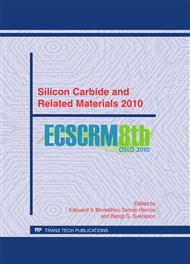p.401
p.405
p.409
p.413
p.417
p.421
p.425
p.429
p.433
Influence of Annealing Parameters on Surface Roughness, Mobility and Contact Resistance of Aluminium Implanted 4H SiC
Abstract:
The impact of implantation temperature and dose as well as the annealing process with and without a graphite capping layer on surface roughness, carrier mobility and specific contact resistance are investigated and compared. The use of the capping layer is proven to be particularly advantageous: (1) a deterioration of surface roughness can be avoided even for high dose implantations and (2) the specific contact resistance is reduced. Furthermore, it is shown that a capping layer prevents surface contamination during annealing.
Info:
Periodical:
Pages:
417-420
Citation:
Online since:
March 2011
Authors:
Price:
Сopyright:
© 2011 Trans Tech Publications Ltd. All Rights Reserved
Share:
Citation:


